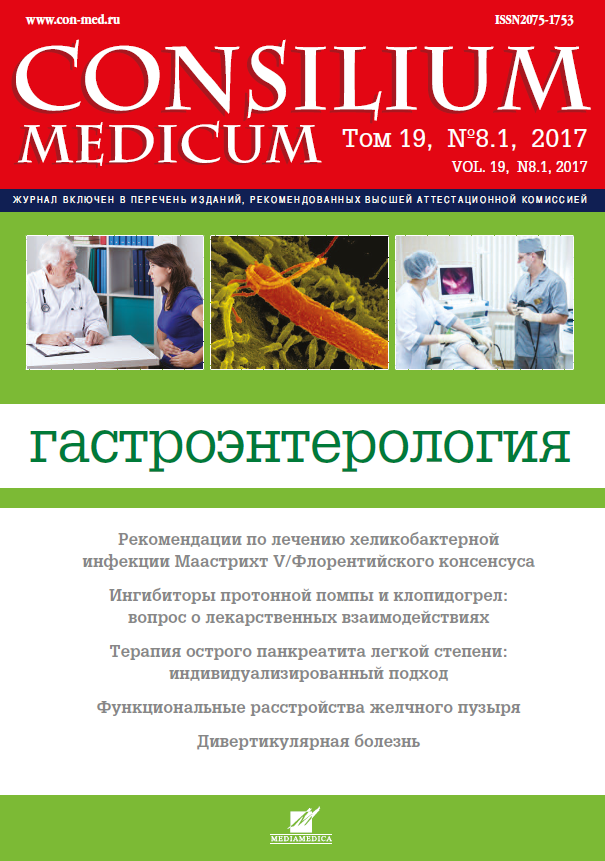Vol 19, No 8-1 (2017)
- Year: 2017
- Published: 17.08.2017
- Articles: 5
- URL: https://consilium.orscience.ru/2075-1753/issue/view/4835
Full Issue
Articles
Recommendations of the Maastricht V/Florence consensus for the Helicobacter pylori infection treatment
Abstract
The purpose of the work is to analyze section of the Maastricht-V-Florence consensus dedicated of Helicobacter pylori (H.pylori) infection treatment. H. pylori resistance rates to antibiotics are increasing in most parts of the world. For any regimen, the eradication rate can be predicted if the cure rates are known for susceptible and resistant strains and the prevalence of resistance in the population. For an individual patient a history of any prior use of one of the key antibiotics proposed will identify likely antibiotic resistance despite low resistance rates in the population. Susceptibility based results simultaneously provide results that are both population- and individual-based. In areas of high (>15%) clarithromycin resistance, bismuth quadruple or non-bismuth quadruple, concomitant (proton pump inhibitor - PPI, amoxicillin, clarithromycin and a nitroimidazole) therapies are recommended. In areas of high dual clarithromycin and metronidazole resistance, bismuth quadruple therapy is the recommended first-line treatment. The treatment duration of bismuth quadruple therapy should be extended to 14 days, unless 10 day therapies are proven effective locally. The treatment duration of triple therapy with clarithromycin should be extended to 14 days. In areas of low clarithromycin resistance, triple therapy is recommended as first-line empirical treatment. Bismuth-containing quadruple therapy is an alternative. The use of high dose PPI twice daily increases the efficacy of triple therapy. Esomeprazole and rabeprazole may be preferred in Europe and North America where the prevalence of PPI extensive metabolisers is high. After failure of bismuth-containing quadruple therapy, a fluoroquinolone-containing triple or quadruple therapy may be recommended. In cases of high quinolone resistance, the combination of bismuth with other antibiotics, or rifabutin, may be an option. In general, when compared with the previous consensus, for the treatment of H. pylori infection more aggressive antibiotic therapy is offered.
Consilium Medicum. 2017;19(8-1):8-27
 8-27
8-27


Individualized antisecretory and polyenzyme therapy of mild acute pancreatitis
Abstract
The article is devoted to the study and elaboration of principles of differentiated antisecretory and multienzyme therapy of acute edematous pancreatitis. The aim: to evaluate the effectiveness of high doses of multienzyme preparations for the treatment of acute edematous pancreatitis in comparison with the main antisecretory drugs and to determine the main indications for the differentiated application. Material and methods. This article uses the results of treatment of 165 patients with acute mild pancreatitis of different etiology using only basic therapy (11 patients - 6.7%), various antisecretory drugs (91 patients - 55.2%) and multienzyme preparation, Ermytal 36 000 (63 patients - 38.2%). Verification of diagnosis was carried out based on the typical complaints and medical history, ultrasound, fibrogastroduodenoscopy and laboratory research. Results. A review of the literature on the mechanisms of negative feedback is allowed to justify the use of high doses multienzyme drugs to suppress the release of pancreatic enzymes and functional rest the pancreas during acute edematous pancreatitis. Based on the statistical analysis assessed the impact of antisecretory and multienzyme preparations on dynamics of the main pathophysiologic changes in patients with acute pancreatitis mild. Own data have confirmed the efficacy of the drug, Ermytal 36 000. Based on this, the principles of differentiated antisecretory therapy and worked out indications for use of high doses of multienzyme preparations in the treatment of acute pancreatitis are mild. Differentiated antisecretory therapy and the use of multienzyme preparations allowed us on the background of the annual growth of total incidence of acute pancreatitis is to decrease the frequency of readmissions from 10.5% to 1.6%.
Consilium Medicum. 2017;19(8-1):28-34
 28-34
28-34


Functional disorders of the gallbladder in the practice of the therapist
Abstract
The article discusses the problem of functional biliary disorders, particularly functional disorders of the gallbladder: new views of etiopathogenetic mechanisms of development of this pathology, modern clinical and laboratory criteria for diagnosis, the rules of the formulation of the diagnosis, approaches to pharmacological and surgical treatment proposed working scheme of therapy and prevention of the disease, from the perspective of the Roman criteria IV taken in 2016, and our own clinical experience.
Consilium Medicum. 2017;19(8-1):35-41
 35-41
35-41


Diverticular Disease of the Colon
Abstract
In elderly patients with periodic not food-related abdominal pain and stool disorders (diarrhea/constipation) when radiography of the colon and colonoscopy often exhibit multiple protrusions of the walls of the colon - diverticula. This pathological syndrome - diverticulosis, diverticular disease of the colon is characterized by recurrent abdominal pain, disorders of stool and in severe form is acute inflammatory complications, requiring emergency surgery.
Consilium Medicum. 2017;19(8-1):42-44
 42-44
42-44


Topical drug interactions: in focus proton pump inhibitors and clopidogrel
Abstract
Drug interactions are one of the topical issues of rational pharmacotherapy in modern clinical practice from the standpoint of comorbidity and drug safety. Antiaggregant therapy is represented by a wide range of drugs, the most commonly used in clinical practice are acetylsalicylic acid and clopidogrel. To reduce the risk of formation of gastrointestinal complications with the use of antiplatelet therapy, the use of proton pump inhibitors is recommended. The article discusses the features of the joint use of clopidogrel and various proton pump inhibitors, as well as the results of a meta-analysis on this drug interaction problem, published in 2016.
Consilium Medicum. 2017;19(8-1):45-48
 45-48
45-48











